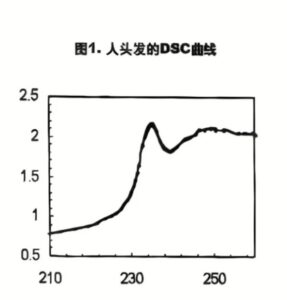1.Introduction
When studying the structural changes of the microfiber-matrix complex of keratin samples, DSC can be used to analyze the changes in thermal stability, phase transition behavior, and possible melting or decomposition processes of keratin before and after heat treatment. For example, the DSC curve can be used to observe the endothermic or exothermic peaks that may appear in keratin during heating. These peaks correspond to the movement of keratin molecular chains, the melting of microfibers, or the denaturation of proteins.
By comparing DSC curves before and after stretching and heat treatment, researchers can understand the effects of these treatments on the thermal properties and structural stability of keratin composites. For example, heat treatment may lead to an increase in cross-linking between keratin molecules, thereby improving the thermal stability of the material, while stretching may change the crystallinity of keratin and affect its thermal behavior.
2.Experimental steps
- Material preparation
Samples of untreated brown hair, untreated hair and bleached yellow hair.
- Sample preparation
After cleansing, divide hair into several small pieces, about 5-7 mg.
- Water content
The hair samples were placed in a chamber at 23 degrees Celsius and 50% relative humidity for 48 hours. After equilibration, the moisture content of the bleached hair and the untreated brown hair was 11.48% and 10.15%, respectively.
- Measuring instruments
Instrument name: DSC3000C differential scanning calorimeter
Instrument brand: Xiangyi Instruments Xiangtan Limited

3.Results and Discussion
- Data Analysis

Figure 1 is a typical DSC curve of a hair sample that has not been treated in any way. The peak temperature is defined as the denaturation temperature (Td) of the a-helix in IFs. Denaturation includes phase transition and protein degradation. The area of the peak represents the denaturation △Hd, which is the energy required for the denaturation of the a-helix and is expressed as the amount of heat absorbed per gram of dry hair (J/g). △Hd is used to calculate RHC, RHC=100x(△Hd/△Hd0)%, where △Hd0 is the average denaturation melting point of hair that has not been treated in any way.
- The impact of weather and environment on hair
We investigated different parts of an 18 cm long brown hair sample that had not been treated in any way and studied the spiral absorption peak of the scanning curve. The results are shown in Table 1.
.jpg)
It can be seen that △Hd decreases from the hair tip to the hair root, while Td increases continuously. The RHC value of the hair tip is 85.6% of that of the hair root. It is obvious that the weather environment has a great impact on the hair, because the closer to the hair tip, the longer the contact time with the environment.
- The effects of bleaching and relaxing on hair
.jpg)
Figure 2 reveals the effect of bleaching time on Td and RHC of untreated hair. RHC value decreases with increasing bleaching time. △Hd of untreated hair and bleached hair are 3.85 J/g and 1.07 J/g respectively. After treatment, RHC of bleached hair is 72.8% lower than that of untreated hair. This result shows that bleaching treatment seriously damages hair. Scanning electron microscopy (SEM) observations show that there are many visible holes and cuticle damage on the surface of bleached hair. Td increases with increasing bleaching time. This is because the size of Td depends on the cross-linking density of the matrix. The higher the cross-linking density, the higher the viscosity and the greater the resistance to the helical/coil transition in IFs. It is known that the content of cysteic acid (oxidation product of cysteine during bleaching) increases with the extension of bleaching time. Therefore, the increase of Td reflects the increase of cysteic acid and the further enhancement of ionic interaction. We also observed that Td increases and △Hd decreases for Afro-American hair with increasing relaxation time.
- Restoration of spiral peaks – hair reconstruction
The hair was treated with different protein derivatives before and after bleaching. The results are shown in Table 2.
.jpg)
Table 2
The RHC of hair samples treated with hydrolyzed wheat protein cystine polysiloxane, hydrolyzed wheat protein and para-propyl polysiloxane mixture increased by 77.5%, 72.0% and 88.8%, respectively. Td was significantly reduced after treatment with protein. Previous studies have shown that both hydrolyzed wheat protein and cystine polysiloxane can enter the hair by exchanging disulfide bonds with cystine residues on the hair. This exchange will change the number and structure of helices in the hair, which is characterized by an increase in △Hd and a decrease in Td. We found that leave-on products restore the absorbance peak better than wash-off products. Generally speaking, high molecular weight protein derivatives such as hydrolyzed wheat protein and propyl polysilicone blend cannot penetrate the hair due to their large size. As mentioned previously, the bleached hair samples were severely damaged and had a porous surface, and this porosity allowed the polymer to enter and act on the hair. Perhaps it is this permeation effect that explains the significant increase in aHd in bleached hair treated with the polymer. We also found an increase in ΔHd and a decrease in Td after the application of the protein derivative to relaxed hair.
- Experimental Spectrum
.jpg)
Figure 3: This is our company’s test results and analysis of human hair tissue test spectrum
